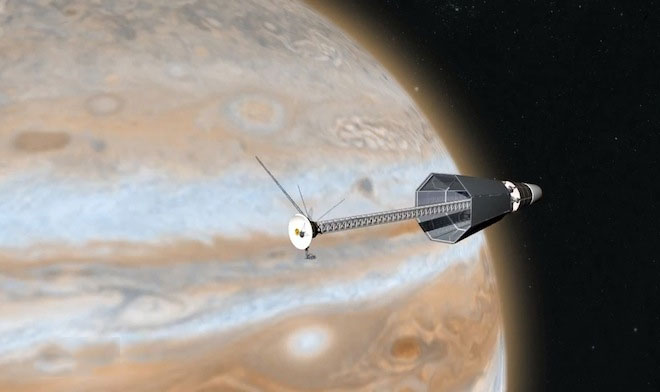Space exploration with 19th-century motives
Researchers have experimented with a small version of a nuclear engine design that can help satellites explore deep into the universe.
Scientists at NASA's Glenn Research Center and Los Alamos National Laboratory have just tested a small prototype using smaller nuclear energy and a Stirling engine. This model produces about 24w / h. This is a test of the nuclear reaction system to power the first spacecraft in the US since 1965.
Most exploratory satellites require an energy level of about 600w-700w, so there is still a gap that scientists need to overcome before being able to actually use this solution for a spaceship.

Simulation satellites using Stirling engines
Simulation satellite, using Stirling engine. The design is based on the Stirling engine - an engine first invented in the 19th century (which uses hot air compressed to make piston motion).
Nuclear engines are very important because they can help people explore to the entire solar system. In addition to Mars, sunlight shines on other planets in the solar system that do not provide enough energy for solar cells to serve as a satellite as well as to transmit information about the Earth ( This requires a solar battery of the same area as a football field.
Over the past few decades, NASA has used plutonium-238 to power exploratory satellite models including Voyager and Cassini satellites that are operating in orbit around Saturn.
However, since the early 1980s, the United States began to cut down on the amount of plutonium produced and stopped in 1992. Curiosity vehicles are operating on Mars using the last plutonium of America.
In 2011, NASA and the US Department of Energy received about $ 10 million to restart the plutonium production program with an output of several kilograms per year. This small amount of plutonium will be used for space exploration programs.
Reference: Wired
- The life of people in the bottom of society in London in the 19th century
- 19th century China through rare photos
- Objects similar to smartphones in the 19th century painting
- Rare photos of British colonial India in the 19th century
- Photos of life in China in the late 19th century
- What do you know about 19th-century television with
- Discovered two missing ships from the 19th century when searching for MH370
- Modern people are not as intelligent as people of the 19th century?
- Unexpectedly discovered the mysterious 19th century shipwreck in the Gulf of Mexico
- Excavating a grave in the 19th century
- It was the 'culprit' that made the ships change their speed when in outer space
- Mummy woman froze 200 years
 Van Allen's belt and evidence that the Apollo 11 mission to the Moon was myth
Van Allen's belt and evidence that the Apollo 11 mission to the Moon was myth The levels of civilization in the universe (Kardashev scale)
The levels of civilization in the universe (Kardashev scale) Today Mars, the sun and the Earth are aligned
Today Mars, the sun and the Earth are aligned The Amazon owner announced a secret plan to build a space base for thousands of people
The Amazon owner announced a secret plan to build a space base for thousands of people